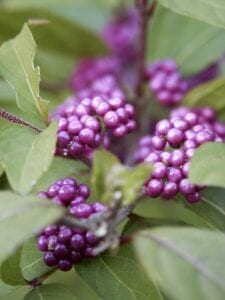 With a name like Beautyberry, it certainly isn’t difficult to surmise what ornamental attribute makes this medium sized, deciduous shrub garden worthy. Botanically known as Callicarpa, the striking, glossy lilac-purple berries provide tremendous eye candy in late summer/early fall. And while the berries alone provide enough incentive to make Callicarpa a member of any garden, the following reasons can make one wonder why it isn’t in yours already.
With a name like Beautyberry, it certainly isn’t difficult to surmise what ornamental attribute makes this medium sized, deciduous shrub garden worthy. Botanically known as Callicarpa, the striking, glossy lilac-purple berries provide tremendous eye candy in late summer/early fall. And while the berries alone provide enough incentive to make Callicarpa a member of any garden, the following reasons can make one wonder why it isn’t in yours already.
Culturally speaking Callicarpa is extremely easy to grow. It is highly adaptable to most well drained soils, and thrives in full sun to moderate shade. The shade tolerance is actually quite impressive as there are many established specimens thriving under the bright shade of tall White Pines and Hemlocks. However, best growth, flower, and therefore berry production does occur in more sun. Also, while a single specimen will set a very satisfactory berry display, cross-pollination increases production and therefore planting multiple shrubs in groups or masses will provide for a much more dramatic display.
Maintenance and care are easy as well – Callicarpa is fully hardy and extremely durable for Long Island gardens; there are no serious diseases or pests to worry about; tolerable soil moisture ranges from fairly dry to fairly saturated; and flowers and fruit occur on new growth, therefore there are no special pruning rules to follow. At minimum, the only necessary pruning includes the removal of dead wood (there’s always going to be some), and the occasional undesirable branch. And at most, one could cut back all branches to approximately 12” every late winter/early spring before new growth for increased results.
Planning and designing your garden with Callicarpa will be easy too as the fine textures of the foliage, pink-purple-lilac flowers, fruit, and gracefully arching stems will pair nicely with most evergreens and perennials. The combinations with other plants are near endless, but suggestions include Holly, Pyracantha, Nandina, Sedum, Rudbeckia, and Heuchera. Groupings of 3 or more, informal hedgerows, and mass plantings are highly recommended when utilizing Beautyberry in the landscape. Open woodlands and other informal settings will be best, but the more compact and dense growing varieties could be easily adapted to more formal situations.
The berries, while edible and can be used for making a decent jelly, are enjoyed far more by birds and other wildlife. The late summer flowers will attract butterflies and bees, and the crushed foliage is known to be a very good external repellent of mosquitoes and ticks! Recent research as also suggested that some species have anti-cancer potential.
While there are over 100 species known, Long Island gardeners will find cultivars of C. dichotoma, C. americana, C. japonica & C. bodinieri available, ranging in mature sizes of 4-8’ with gracefully arching stems. The differences between them are mostly irrelevant for gardening applications, but do exist nonetheless.
